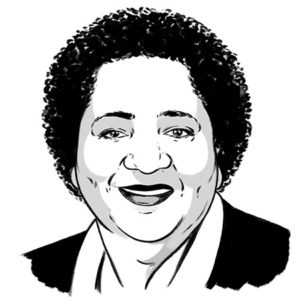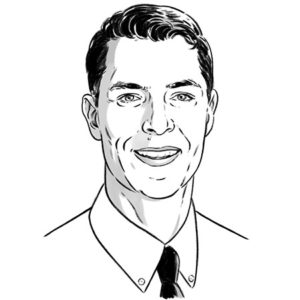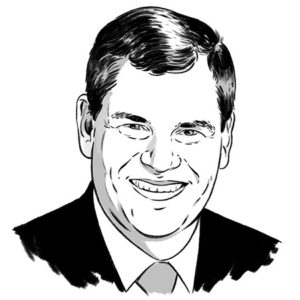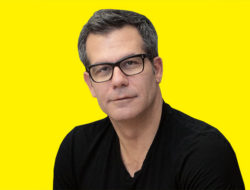If technology has disrupted everything from how we shop to how we drive to how we work, it only makes sense that it should have fundamentally changed how we learn. Except that it hasn’t.
Or at least not at the rate that it’s revolutionized other parts of life. From K-12 to higher education, the “system” of how we learn in America hasn’t changed much in the last 100 years, and what change has occurred is slow. But the subject is bubbling up faster and faster, so we asked a few local experts for their perspective on what’s working, what’s not—and most importantly, what’s next in the education space.
Push for change, and then push again
Shirley Weber, California State Assembly

Shirley Weber has challenged some of the state’s most powerful political groups—even the California Teachers Association.
Which isn’t exactly common among Democrats like her. The San Diego assemblywoman’s reputation for defying the status quo—among the teachers’ union and Republicans alike—has raised her profile across the state.
“Sometimes the labor folks get up and they’ll make it sound like it’s the worst thing in the world. Oftentimes that’s driven by a group of folks who don’t want change.”
For Weber, change in higher education starts in K-12.
“We realized that these kids entering into our community colleges—and now also our CSUs—are not getting adequate K-12 education,” she says. “So we’ve instituted a number of things, whether it’s counseling or making sure they have the right kind of remedial assistance, and implemented pilot programs.”
She’s set her sights on further reform, much of which challenges influential interests. This year she introduced AB 1321, which would demand greater fiscal transparency over funds intended for disadvantaged students. Governor Jerry Brown has opposed more detailed accounting of these funds at the school level.
“The only challenge people think we have to meet in education is to get more money, and not deal with all the other things that make up the system. And that makes me sad. But I continue to work on it anyway.”
Another one of her bills would lengthen a teacher’s probationary period from two years to at least three—and potentially up to five. But it hit a wall due to opposition from the California Teachers Association. Weber reportedly plans to reintroduce the bill next year.
Weber’s passion for challenging entrenched institutions across the political spectrum comes from her family. Her parents fled the segregated South for Los Angeles, and her father preached that education is all-important in clearing a path for a better future.
“He said, ‘They may try to hold you back or deny you opportunities, but they can’t take education from you.’”
Show me your skills!
Ed Hidalgo, Cajon Valley School District

During a previous gig at Qualcomm, Ed Hidalgo helped launch a program that helped employees align their strengths with career aspirations. A powerful realization struck: The group most likely to get the most out of this career counseling was students.
This sparked the Qualcomm Thinkabit Lab, where middle schoolers get hands-on introductions to jobs in fields like engineering, math, and the arts.
The experience convinced Hidalgo that career- and skills-based learning should be introduced at a young age—a potential antidote for the many who graduate from high school or college without an idea of what to do next.
Hence the new World of Work (WoW) program in grades K-8 of Cajon Valley School District, where Hidalgo recently started as the chief innovation and engagement officer.
“Rethinking higher education, to me, begins in grade school. In this economy, kids need skills. To develop these skills, we need to help them recognize their strengths, interests, and values—and how those might align with career paths. Give them something to aspire to.”
“The goal isn’t to get young students to pick a career. It’s to show them what’s out there, and that they could do it.”
But how do kids figure out their interests, strengths, and values? Hidalgo says teachers are critical to WoW, as are self-assessment surveys and tools, along with half-day student “experienceships” at companies like Illumina.
For a school district with high unemployment—notably among ages 16 to 24—Hidalgo says these experienceships are eye-opening.
“Many of them only know about the jobs they see on TV. But the goal isn’t to get young students to pick a career. It’s to show them what’s out there, and that they could do it.”
Learn while you earn
Dan Campion, Solar Turbines

Solar Turbines needs skilled workers, and young people want a good job without the debt of a four-year degree.
Enter the company’s local apprenticeship program, a partnership with San Diego City College. (City College has also inked apprenticeship agreements with organizations like San Diego Gas & Electric.)
Solar Turbine apprentices—typically a class of 15 to 25—spend time in the classroom while also getting hands-on experience in manufacturing and technical trades. These students “learn and earn,” so they’re paid throughout the four-year program.
Dan Campion, vice president of Turbomachinery Products at Solar Turbines, says private-public partnerships like this bridge the so-called skills gap. Why, then, don’t more higher education institutions embrace the model?
One explanation, Campion says, is that it’s costly for community colleges to install apprenticeship infrastructure and equipment—relative to the cost of operating a lecture hall—and such funding challenges deserve to be addressed.
“Higher education could do a better job partnering with industry so that there’s more people with the manufacturing skills that industries need,” he says. “Our community colleges, in general, have taken a more academic approach, and maybe a less skilled-trade approach, to where they don’t have the ability to meet the needs of industry to the extent they potentially could.”
Stay in school, for life
Mary Walshok, UC San Diego Extension

Disruptive technology, declining on-the-job training, and higher standards for entry level skills are trends that warrant a shift to a lifelong learning model, says Mary Walshok, UC San Diego’s associate vice chancellor for public programs and dean of extended studies. She believes that too often, higher education acts as if it’s still 1964—the year she earned her bachelor’s degree—focusing only on classes for 18-to-24-year-olds.
One solution is continuing education, like that offered by UC San Diego Extension. But Walshok says new ways of thinking are needed across higher education institutions.
One bold idea that intrigues her is “the open-loop university,” as envisioned by Stanford: Students would undertake a total of six years worth of studies, but could start when they’re ready and loop back in throughout their lifetime. Student aid—and its accompanying albatross, loan debt—would see much-needed reform in this model as well.
“We need models at every level of higher education that do a better job of blending academic and practical knowledge.”
Imagine starting college at 19 years old, hitting the pause button on classes three years later to launch a startup, and then returning in your 40s or 50s to pick up skills that weren’t around when you were younger.
Walshok says institutions like UC San Diego, SDSU, and San Diego City College are experimenting with new education models—a necessary pivot.
“We need models at every level of higher education that do a better job of blending academic and practical knowledge,” she says. “Universities can assume that workforce readiness is someone else’s business, which is changing, and rightfully so.”
Explain the options (there are many!)
Peter Callstrom, San Diego Workforce Partnership

A Wired article earlier this year declared that coding is “the next big blue-collar job.” Peter Callstrom, president and CEO of San Diego Workforce Partnership, believes the magazine is onto something.
“As the article points out, coders aren’t all whiz kids or Mark Zuckerberg,” he says. “So one way to frame the work is ‘blue collar.’ There are a lot of entry-to-mid-level coding jobs in the county that are unfilled, many of which pay a middle-class wage and don’t require a four-year degree.”
The Workforce Partnership’s mission includes educating high schoolers and those mid-career about such opportunities. It also lays out the costs and benefits of career options. A would-be programmer, for instance, walks away with a better idea of what it takes to obtain a computer science degree versus online training and certificates.
Callstrom says it’s a critical conversation that more people ought to be having, particularly at the high school level—and in underserved populations that are the focus of the Workforce Partnership.
“In our world it’s about helping people find their pathway, whether in workforce readiness or college.”
“As opposed to reforming higher ed, in our world it’s about helping people find their pathway, whether in workforce readiness or college. Four-year degrees are great. But are they for everyone? No. It’s critical for a high schooler or someone mid-career to understand the options in front of them: ‘What is this career? How much might it pay and where could it go? How much training or education is necessary? What are the costs?’ I think that’s been the missing link.”
Invest in employees by wiping out their debt
Kanani Masterson, TriStaff Group

Companies looking to woo indebted millennials have turned to a new benefit: student loan repayment assistance. The number of employers offering tuition reimbursement has also seen a comeback in recent years.
As tuition costs rise, such employer programs can be a win-win, says Kanani Masterson, director of technology and executive search at TriStaff Group. They also show that employers are a big part of the education equation.
“In a competitive job market like today’s, tuition assistance as a benefit is something that’s really attractive to candidates,” she says. “It tells people that that they’ll be able to continue to build out their skill sets, and also shows that the company values investing in their employees. And the employees continue to bring more innovative and current knowledge and learning to the company that they wouldn’t be able to get otherwise—for example, learning more about data mining or big data or the latest in SEO or SEM techniques for digital marketing.”
These skills are especially hot in the San Diego market right now, according to Masterson, who has placed close to 1,000 candidates in her 18 years in the recruitment industry.
Illustrations by Kyle Hilton






























